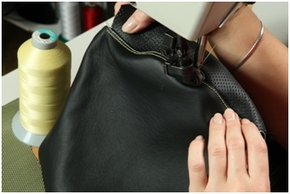For the flexible and also sufficiently rigid connection polyester threads are mostly used which retain about 5 kilograms in tension. In addition, they must be sufficiently resistant to all matters or agents which exist with motorbikes, such as petrol, water solutions and various solvents. Next conditions are resistance to fungal attack and sufficiently long lifetime.
For some parts, we use Kevlar (aramid) threads. They have about a 4 times higher rigidity, but the main reason of their use is a temperature that they withstand. Because during the fall and glide on the asphalt road there is a big formation of heat, the sewed connection could be damaged by high temperature. Polyester threads loose their rigidity at the temperature between 150 and 250 °C, whereas the Kevlar thread withstands the temperature of 400 °C, and in addition, it is more abrasion-resistant. Its disadvantage is a high price and hard work (e. g. the automatic thread cutting cannot be used at the machines).
MULTIPLE SEWING
The seam structure is ever double or multiple and it is valid that at least one sewed connection may not be on the surface of parts not to simple abrade it.
The principle of rigidity of the sewed connection is a thread width, a stitch length and a rigidity and tenacity (rigidity) of the sewed material. It is simply an optimization of three parameters. As thick the fibre is as tenacious is, but we must use a bigger needle that in case of leather it will weaken the material after being inserted. If we use a thin fibre, a thin needle is sufficient but we will need a big number of stitches, i. e. inserts, and it will weaken the leather too much. Optimized for sewing of the connection is on the basis of measurement a loading limit over 100 kilograms per 10 cm of sewing. Therefore we consume nearly 1 000 meters threads for a racing suit.
Picture: Kevlar stitching.





